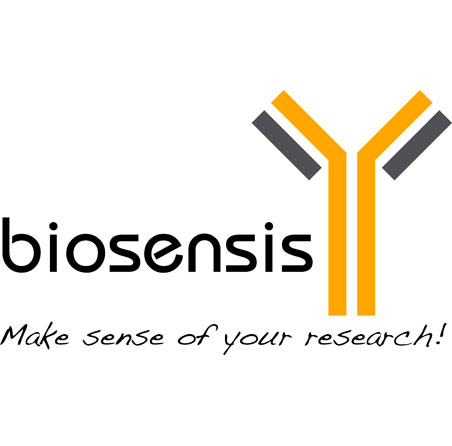Gamma-synuclein, Sheep Polyclonal Antibody
As low as
US$257.00
Only %1 left
Catalog Number
S-069
- Product Name Gamma-synuclein, Sheep Polyclonal Antibody
- Product Description Sheep anti-Gamma-synuclein Polyclonal Antibody (Unconjugated), suitable for WB, IHC-Frozen.
- Alternative Names Persyn; Breast cancer-specific gene 1 protein; Synoretin; SR; SNCG
- Application(s) IHC-Frozen, WB
- Antibody Host Sheep
- Antibody Type Polyclonal
- Specificity Immunohistochemical/western blot anlysis indicate a high level of specificity for this antiserum for gamma synuclein. This antiserum is known to react with human and rat gamma synuclein.
- Species Reactivity Human, Rat
- Immunogen Description A synthetic peptide (EKEEVAEEAQSGGD) as part of human gamma synuclein protein (114-127) conjugated to diphteria toxid has been used as the immunogen.
- Conjugate Unconjugated
- Purity Description Affinity purified and dialysed against PBS. Contains 0.02% sodium azide.
- Regulatory Status For research use only.
Product Info
- Product Description Sheep anti-Gamma-synuclein Polyclonal Antibody (Unconjugated), suitable for WB, IHC-Frozen.
- Application(s) IHC-Frozen, WB
- Application Details IHC, WB. A concentration of 2-5 µg/mL is recommended for both applications. Biosensis recommends optimal dilutions/concentrations should be determined by the end user.
- Target Gamma-synuclein
- Specificity Immunohistochemical/western blot anlysis indicate a high level of specificity for this antiserum for gamma synuclein. This antiserum is known to react with human and rat gamma synuclein.
- Target Host Species Human
- Species Reactivity Human, Rat
- Antibody Host Sheep
- Antibody Type Polyclonal
- Antibody Isotype IgG
- Conjugate Unconjugated
- Immunogen Description A synthetic peptide (EKEEVAEEAQSGGD) as part of human gamma synuclein protein (114-127) conjugated to diphteria toxid has been used as the immunogen.
- Purity Description Affinity purified and dialysed against PBS. Contains 0.02% sodium azide.
- Format Lyophilized
- Reconstitution Instructions Spin vial briefly before opening. Reconstitute in 20 µL sterile-filtered, ultrapure water. Centrifuge to remove any insoluble material.
- Storage Instructions After reconstitution keep aliquots at -20°C for a higher stability, and at 2-8°C with an appropriate antibacterial agent. Glycerol (1:1) may be added for an additional stability. Avoid repetitive freeze/thaw cycles.
- Batch Number Please see item label.
- Expiration Date 12 months after date of receipt (unopened vial).
- Alternative Names Persyn; Breast cancer-specific gene 1 protein; Synoretin; SR; SNCG
- Uniprot Number O76070
- Uniprot Number/Name O76070 (SYUG_HUMAN)
- Scientific Background Gamma synuclein belongs to the synuclein family which are believed to be involve in the pathogenesis of neurodegenerative diseases. High levels of gamma synuclein have been identified in andvanced breast carcinomas suggesting a correlation between gamma synuclein overexpression and breast tumor development. Gama synuclein plays a role in neurofilament network integrity. May be involved in modulating axonal architecture during development and in the adult. In vitro, increases the susceptibility of neurofilament-H to calcium-dependent proteases. May also function in modulating the keratin network in skin. Activates the MAPK and Elk-1 signal transduction pathway. SUBUNIT: May be a centrosome-associated protein. SUBCELLULAR LOCATION: Cytoplasm; perinuclear region. Centrosome. Spindle. Associated with centrosomes in several interphase cells. In mitotic cells, localized to the poles of the spindle. TISSUE SPECIFICITY: Highly expressed in brain, particularly in the substantia nigra. Also expressed in the corpus callosum, heart, skeletal muscle, ovary, testis, colon and spleen. Weak expression in pancreas, kidney and lung. PTM: Phosphorylated. Phosphorylation by GRK5 appears to occur on residues distinct from the residue phosphorylated by other kinases. DISEASE: Brain iron accumulation type 1 (NBIA1, also called Hallervorden-Spatz syndrome), a rare neuroaxonal dystrophy, is histologically characterized by axonal spheroids, iron deposition, Lewy body (LB)-like intraneuronal inclusions, glial inclusions and neurofibrillary tangles. SNCG is found in spheroids but not in inclusions.
- Shipping Temperature 25°C (ambient)
- UNSPSC CODE 41116161
- Regulatory Status For research use only.
Specifications
-
General References
Lundvig, et al Brain Res Mol Brain Res 134, 3-17 (Mar 24, 2005).
Bennett, Pharmacol Ther 105, 311-31 (Mar, 2005).
Vekrellis, et al., Mol Neurobiol 30, 1-21 (Aug, 2004).
Martin, et al., Protein Pept Lett 11, 229-37 (Jun, 2004).
Doherty, et al., Acta Neuropathol (Berl) 107, 169-75 (Feb, 2004).
Goedert, Curr Opin Genet Dev 11, 343-51 (Jun, 2001).
Saito, et al., J Neurol Sci 177, 48-59 (Aug 1, 2000).
Lucking et al. Cell Mol Life Sci. 2000 Dec;57(13-14):1894-908.
Kahle, et al., Ann N Y Acad Sci 920, 33-41 (2000).
Clayton, et al., Trends Neurosci 21, 249-54 (Jun, 1998).

 1800 605-5127
1800 605-5127 +61 (0)8 8352 7711
+61 (0)8 8352 7711
